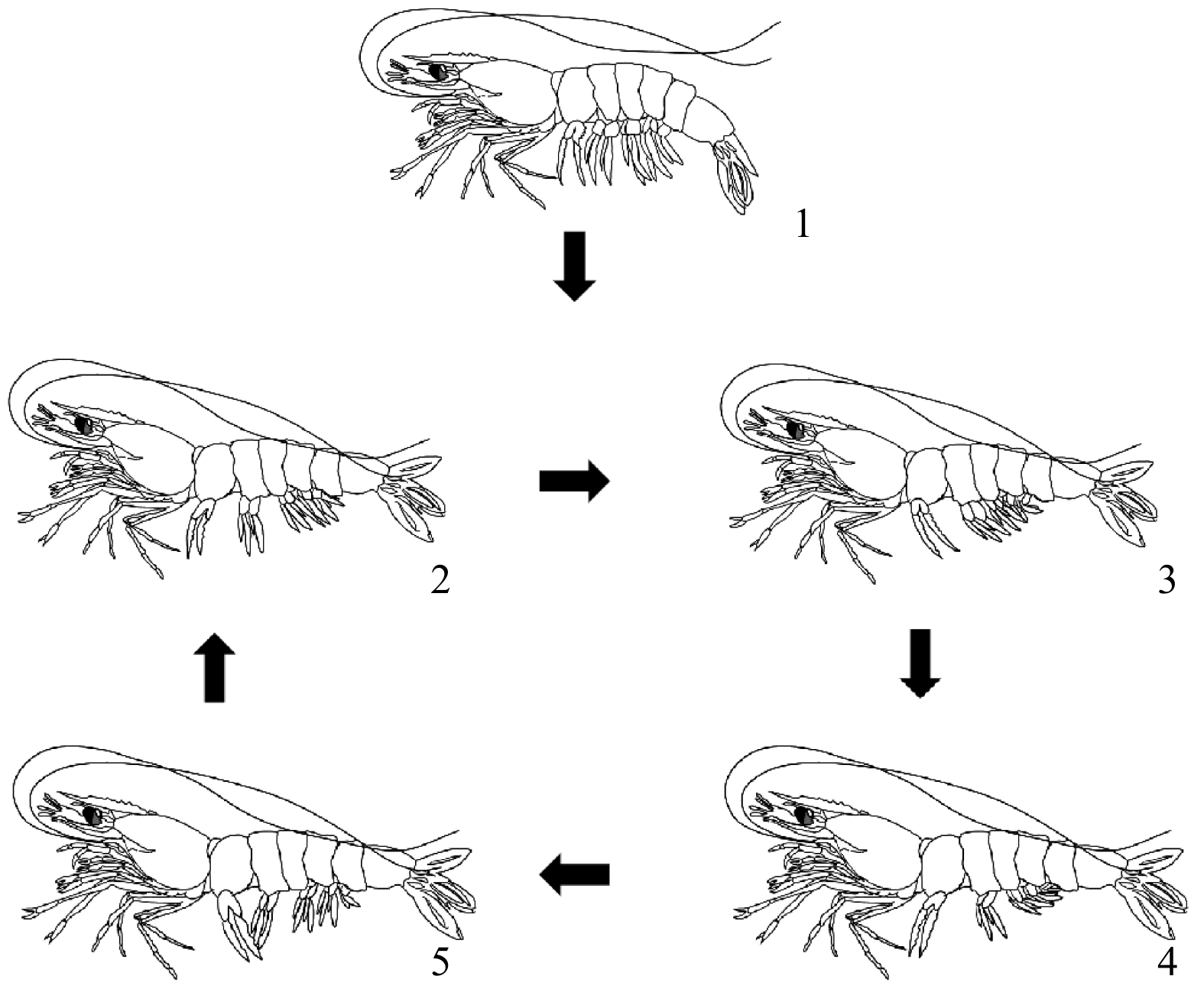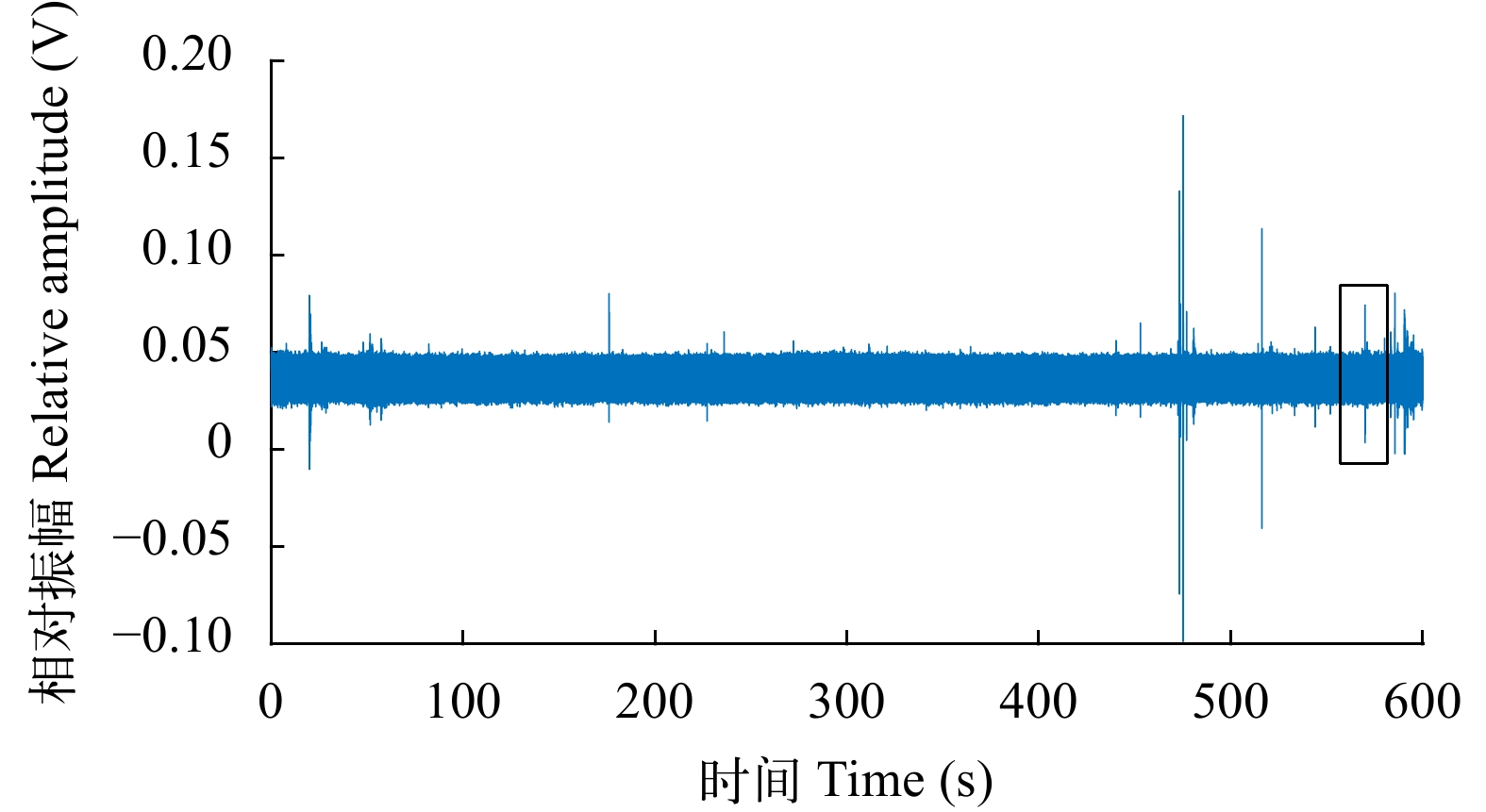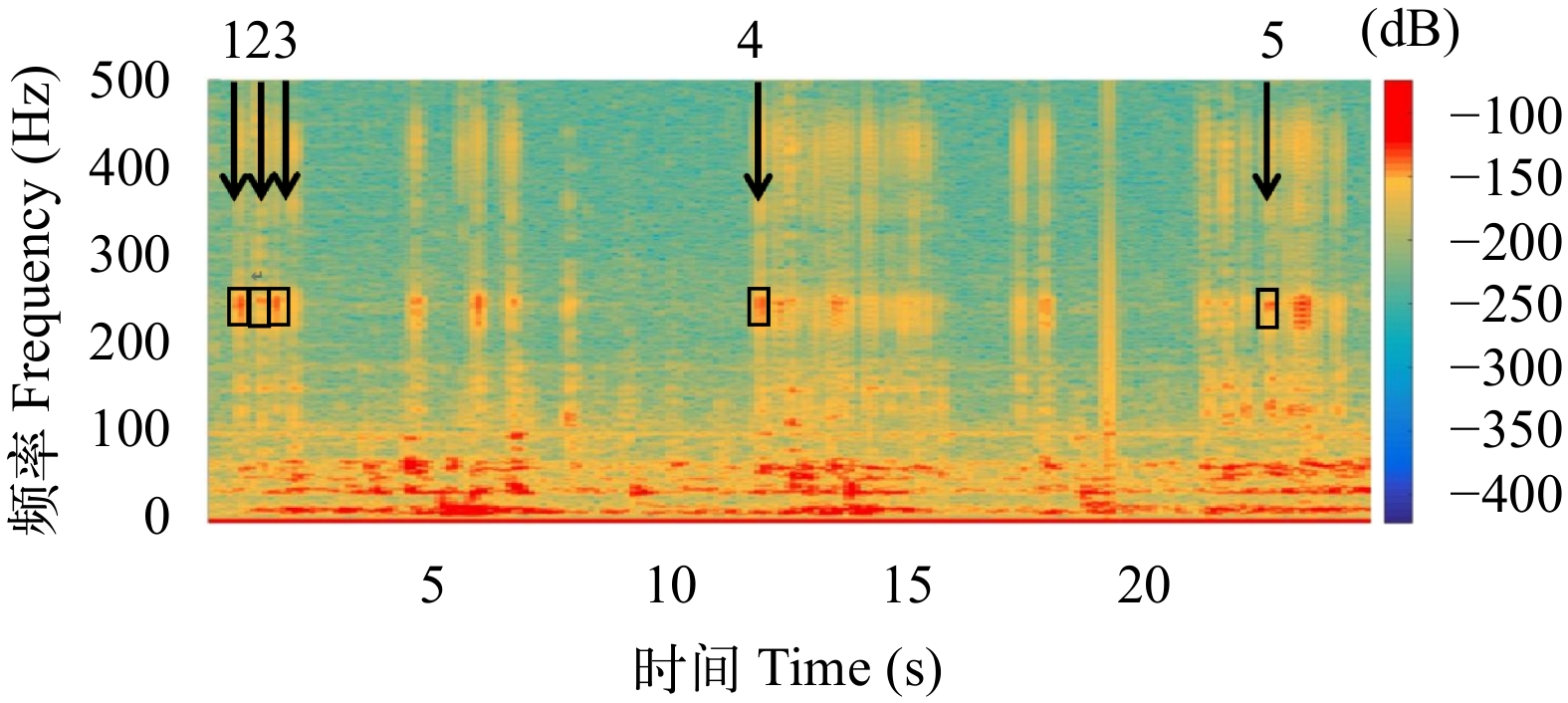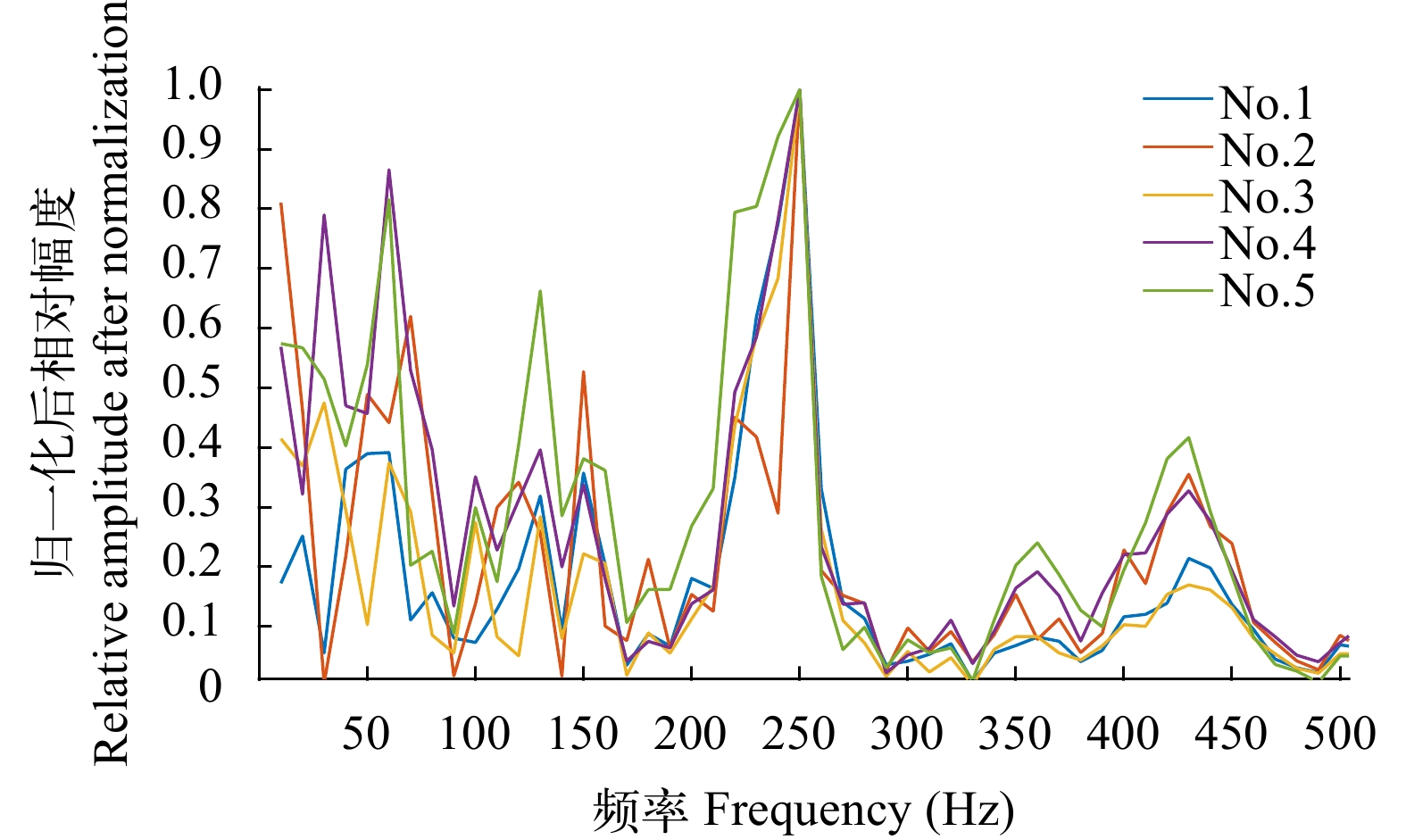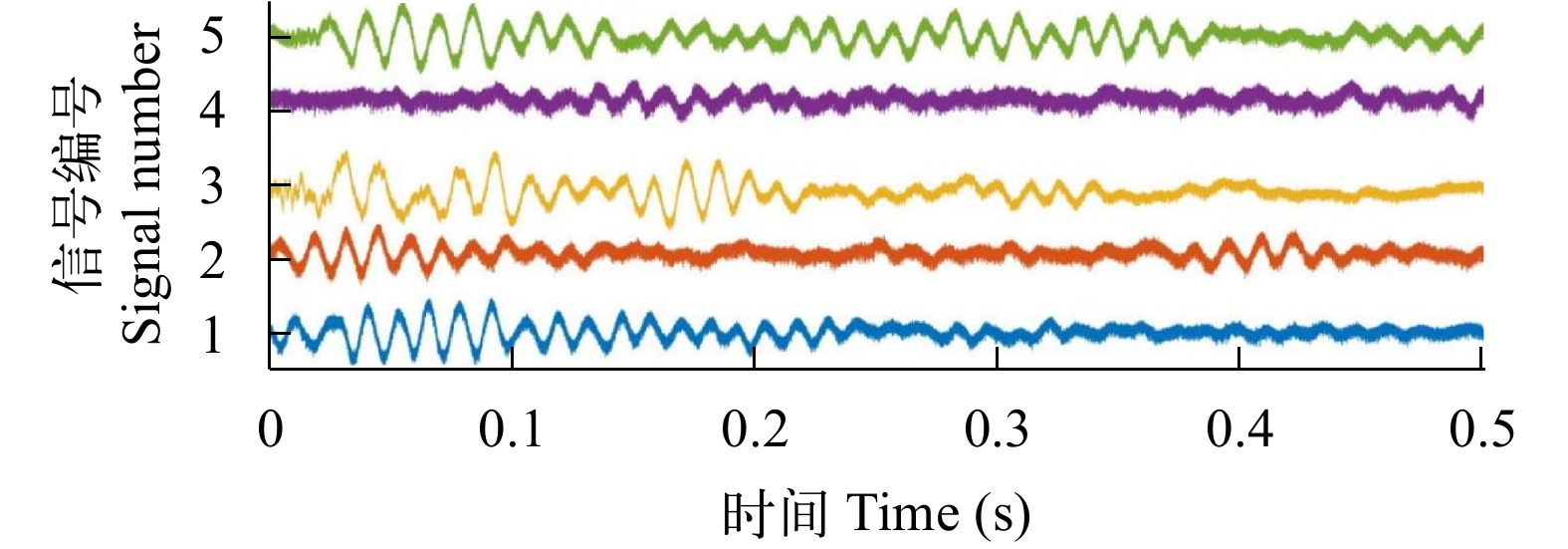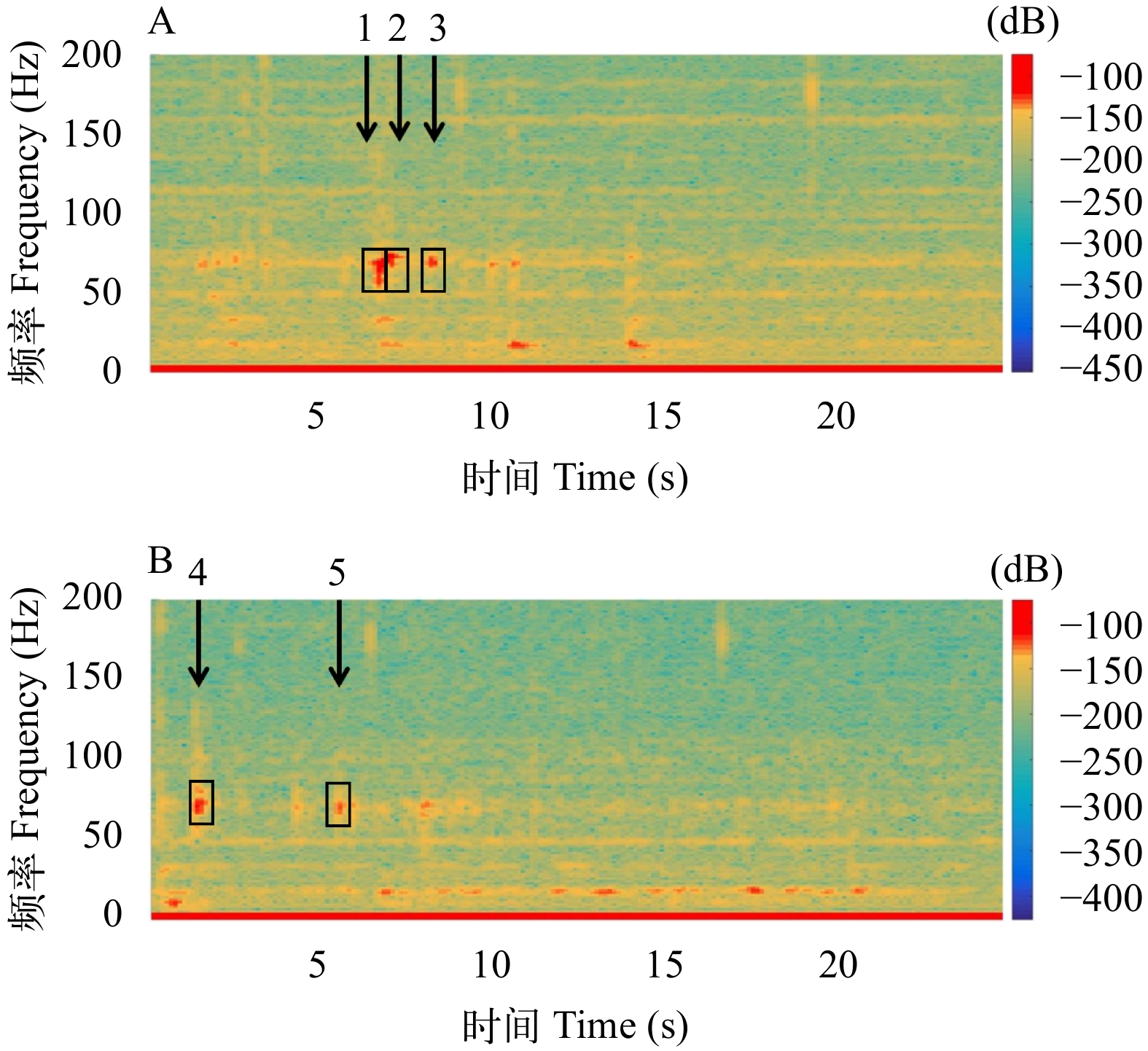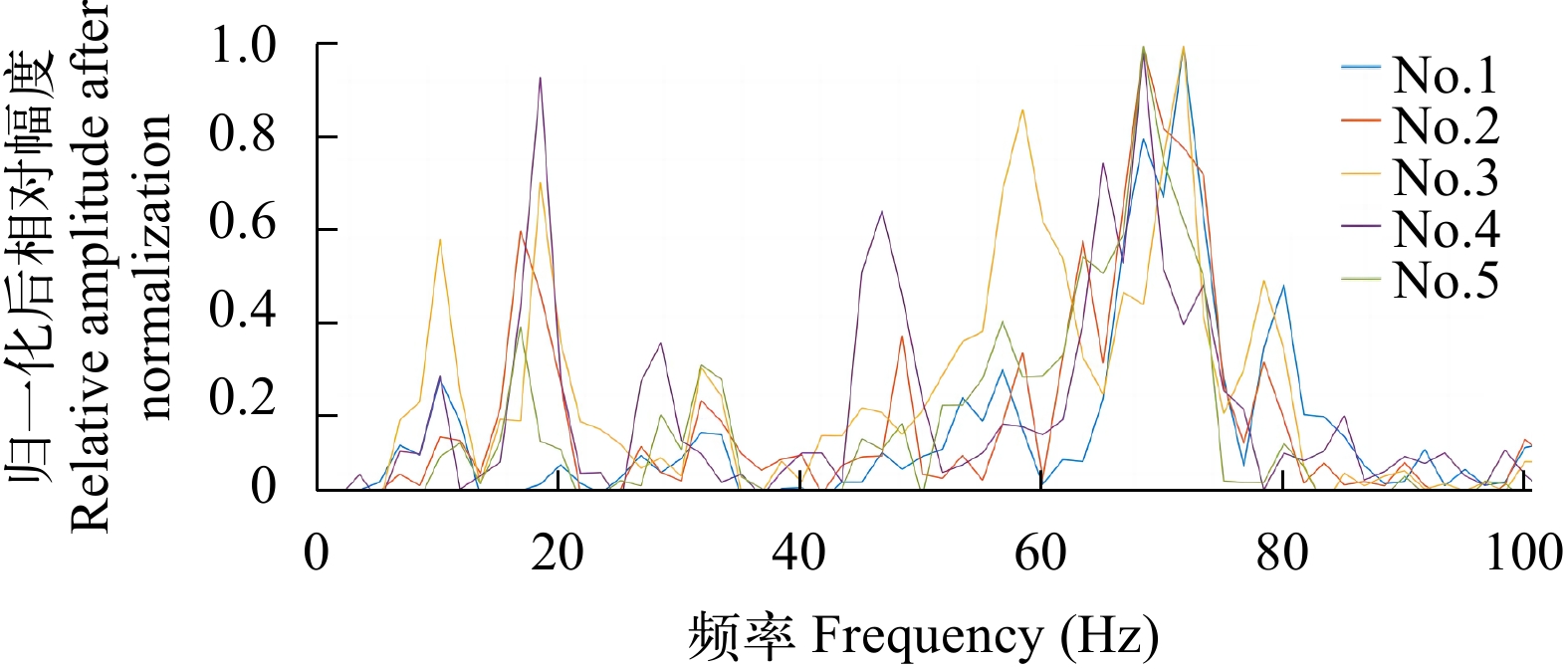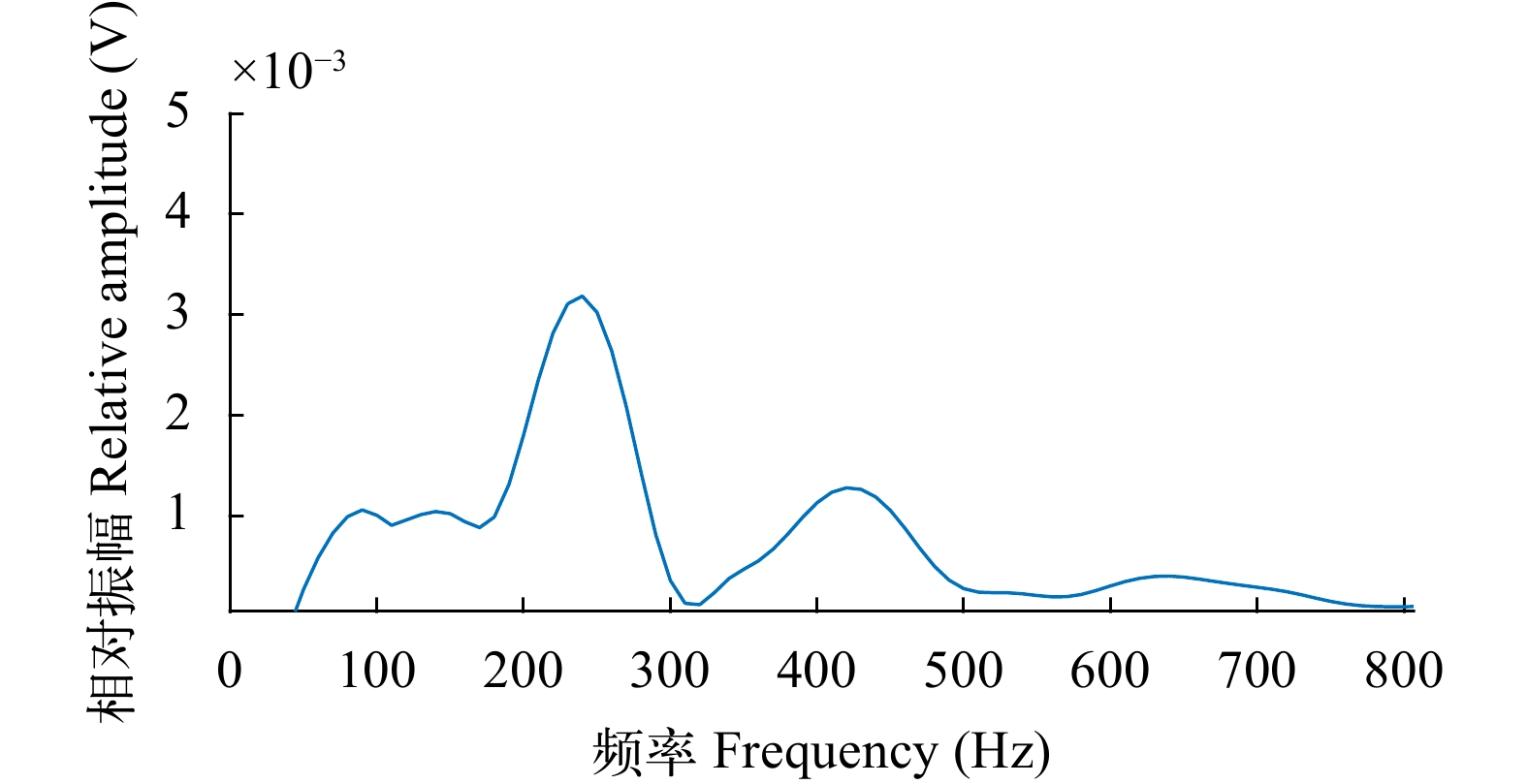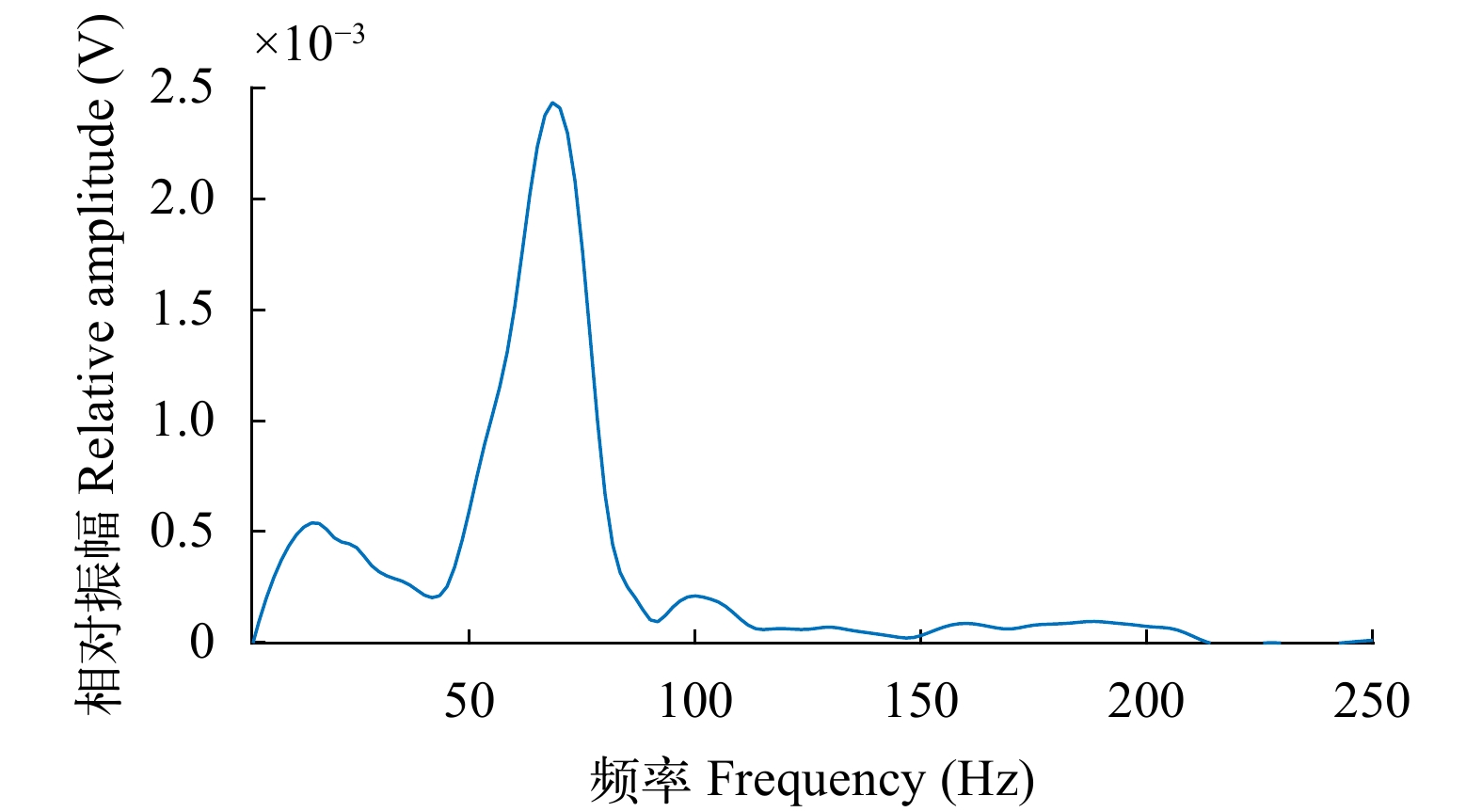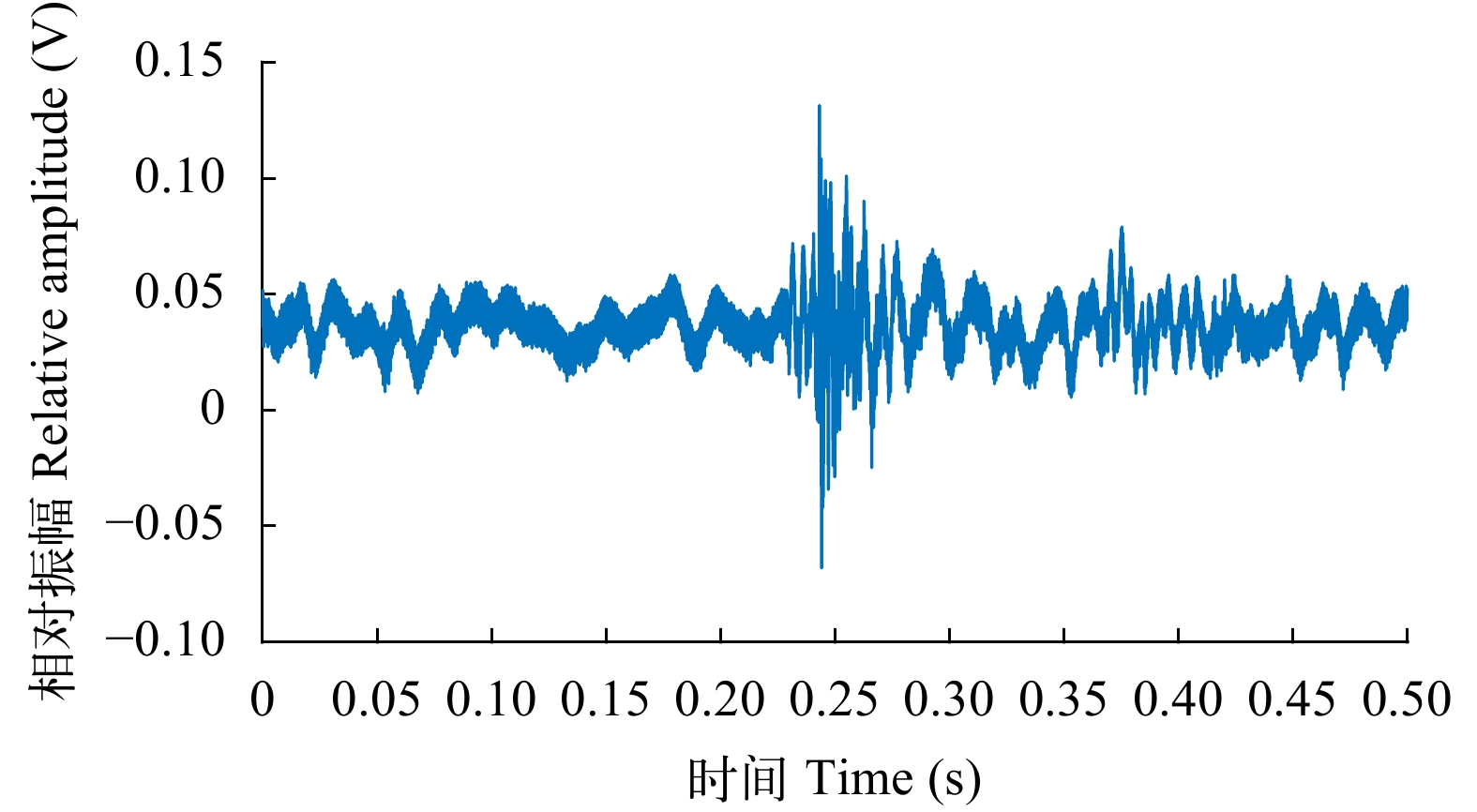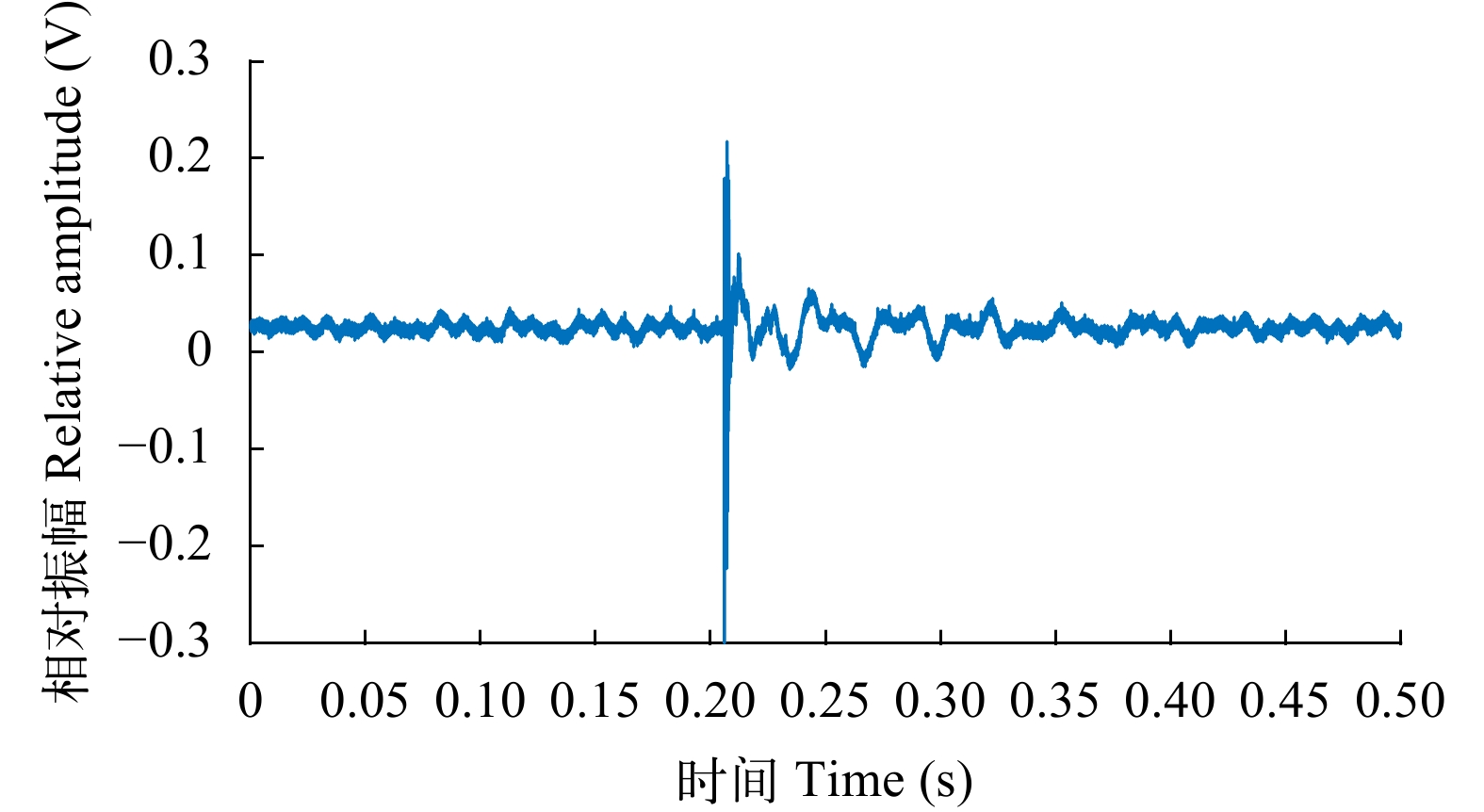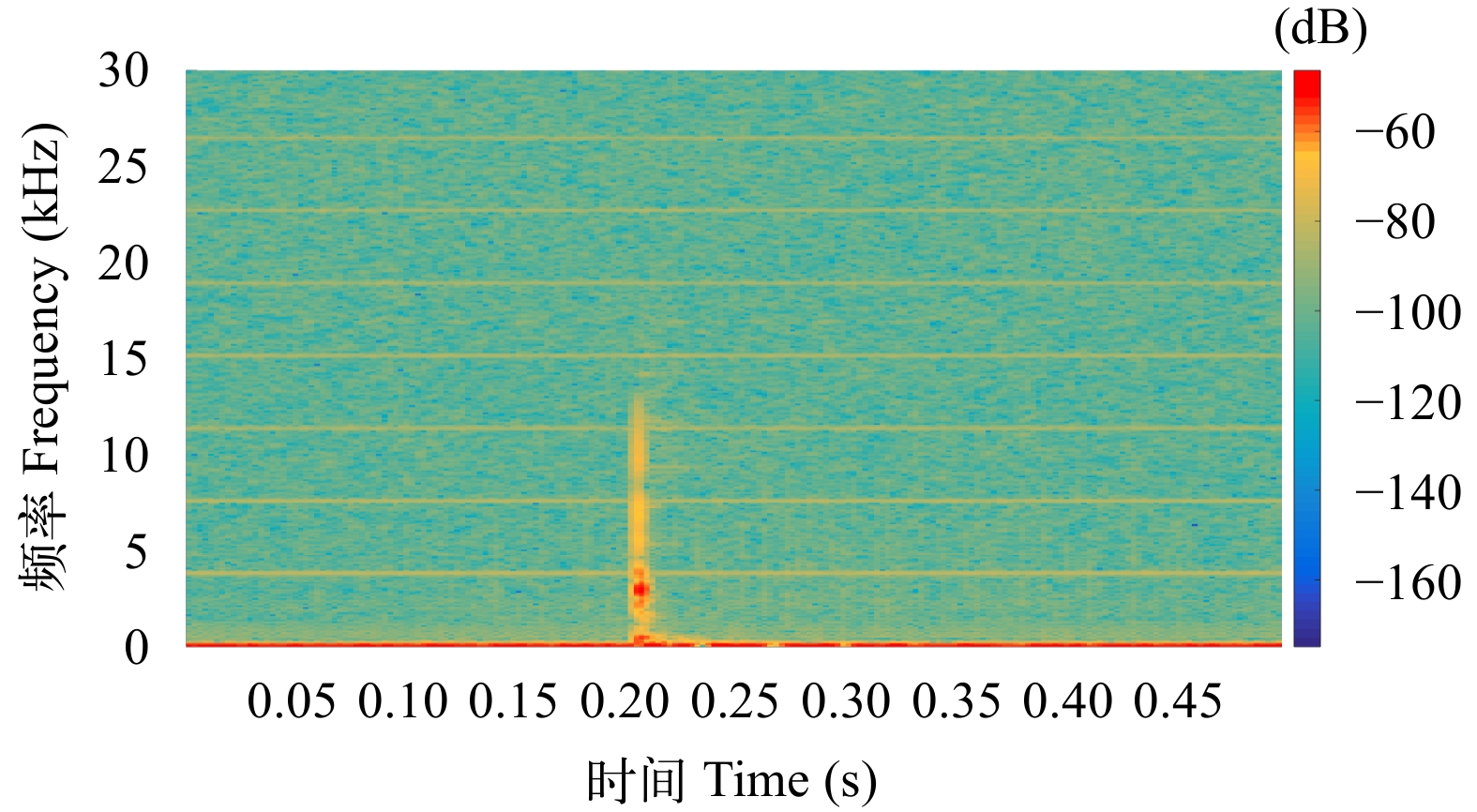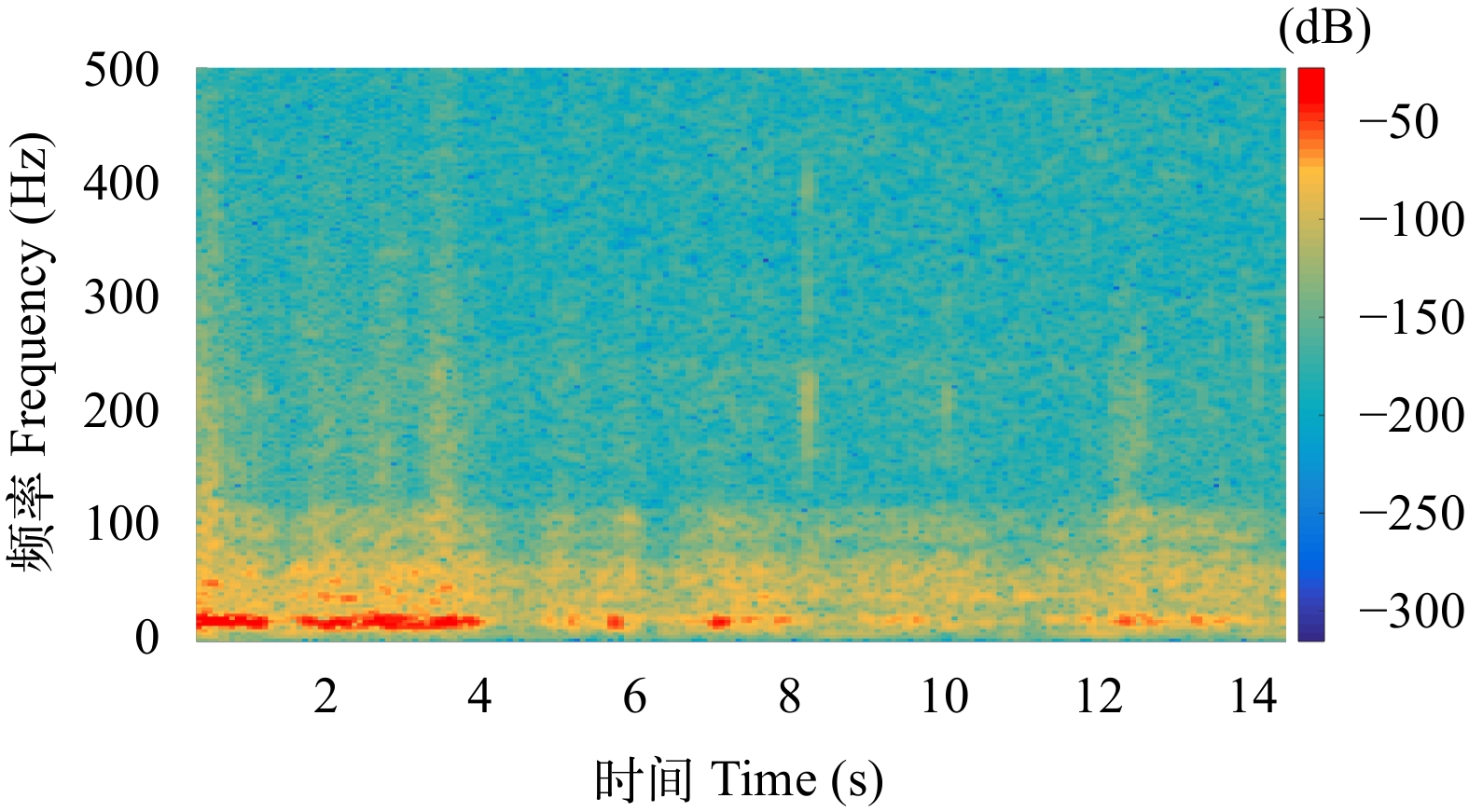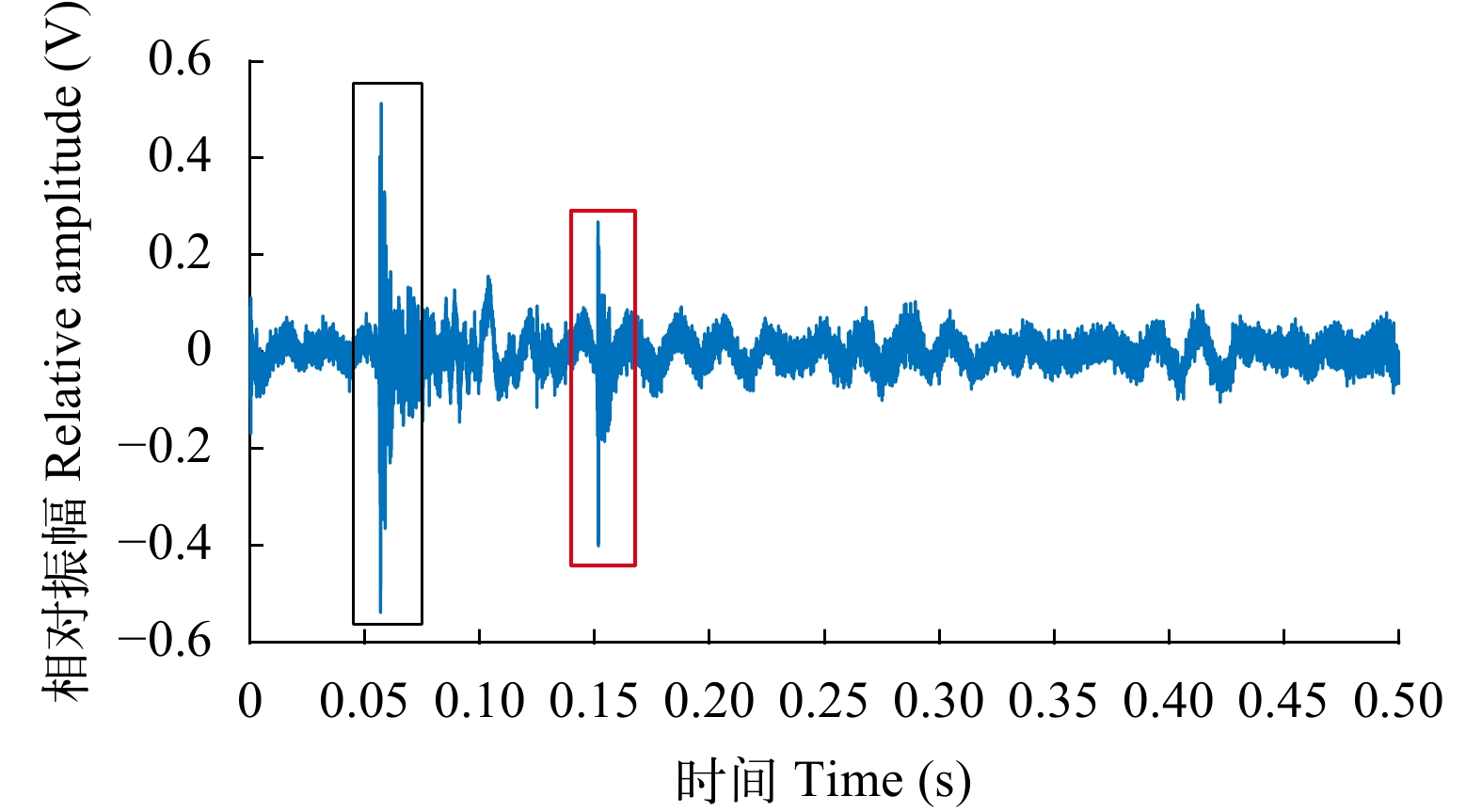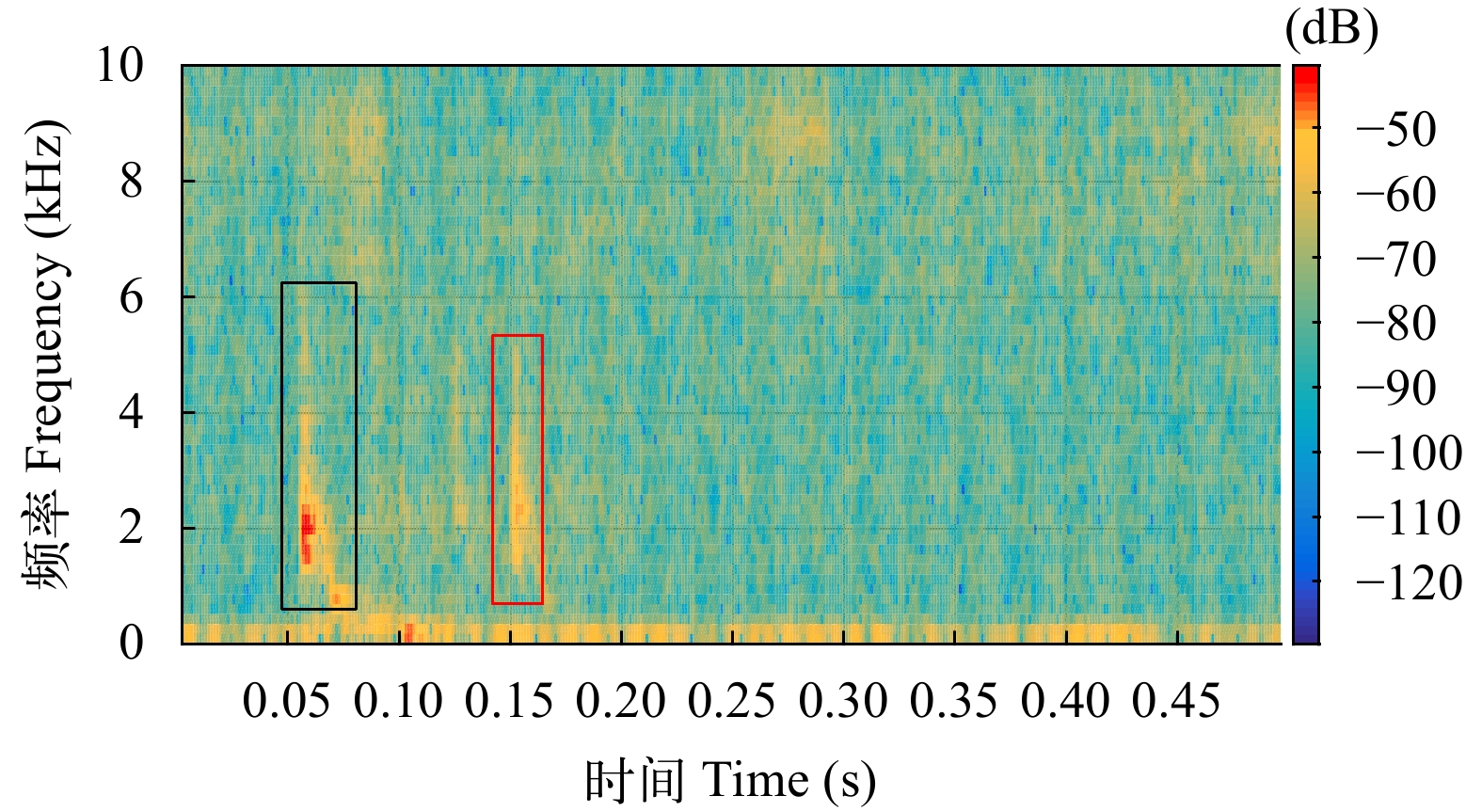ACOUSTIC CHARACTERISTICS OF FAST SWIMMING AND ITS INFORMATION UTILIZATION FOR LITOPENAEUS VANNAMEI
-
摘要: 为了掌握对虾游动发声规律及其信息的利用可能, 文章以南美白对虾(Litopenaeus vannamei)为对象研究了不同游动行为的发声信号特征。首先, 在实验室黑暗条件下利用短时光源刺激南美白对虾, 采集两种规格(小: 4—6 cm; 大: 10—11 cm)对虾的快速游动发声信号, 并分析得出: 小规格对虾的主峰值频率约为250 Hz, 并有次主峰频率约425 Hz; 大规格对虾有约70 Hz主峰频率与约15 Hz的次主峰频率。其次, 确定了游动行为中甩尾弹射的发声信号及其特征, 其中心频率及频带范围均与快速游动发声信号的特征有明显差别。最后, 对比养殖现场环境的水下声音信息发现: 快速游动发声与背景噪声频域特征类似, 部分信号被覆盖; 对虾弹射发声信号可以清晰辨别, 虽与实验室相比该信号的能量集中频率、频率主峰及次主峰频率更低且频率范围要更小, 但其频谱及时频的信号特点与实验室信号有一定的关联性(持续时间均约为0.01s、能量的频率分布均集中于2—3 kHz)。因此, 对虾在游动中的弹射发声信号可作为养殖中监测对虾行为的生物声学信息, 有助于以声学信号监测对虾行为异常和判断生长状况的应用开发。Abstract:White-leg shrimp (Litopenaeus vannamei) as an important aquatic economic species in the world, behavioral acoustics research will help to improve the level of aquaculture. In the present study, two sizes of the white-leg shrimp (4—6 cm TL and 10—11 cm TL) from the nursery of Shanghai Ocean University were investigated. The experiment was conducted in 2 glass tanks (4 cm×28 cm×30 cm) which were shaded. In addition, there were two controllable underwater lights of 10W in each tank. One underwater camera and one hydrophone were fixed in each tank. The hydrophone was 20 cm away from the top and connected to an SM4 recorder. Prior to the experiment, the controlled underwater light and the underwater camera (turned on before placing the water) are placed in the desired location. For each measurement, individual white-leg shrimp was used and acclimated for 40—60min under the dark prior to measuring. Sounds were recorded for 10 minutes after the lights were switched on (a timer controlled the time). Meanwhile, the behaviors of the white-leg shrimp were captured by the underwater camera.The results showed that the main peak frequency of the acoustic signals was about 250 Hz, and the secondary peak appeared near 425 Hz produced by the small white-leg shrimp during fast swimming. The primary peak frequency of acoustic signals was 70 Hz, and the secondary peak was 15 Hz produced by the large shrimp. Further, the center frequency and frequency range of the acoustic signals of the tail flick was significantly different from that of the fasting swimming. We also collected a signal of tail flick from the white leg shrimp in the shrimp pond. The energy range of the signal was 0.5—6 kHz. The energy frequency range was 1—4 kHz, and the maximum concentrated energy frequency was about 2 kHz. Different from the laboratory’s results, the main peak frequency of the signal was about 1.8 kHz, and there was a main secondary peak of about 250 Hz. In comparison to the laboratory data, the pond background noise and the sound produced by the white-leg shrimp during fast swimming were low-frequency signals. The frequency of the signal by tail-flick of the white-leg shrimp was higher than the background noise. The signal duration in the pond and laboratory was about 0.01s, and the frequency distribution of the energy was concentrated at 2—3 kHz. In summary, we studied the fast swimming sound production by two size white-leg shrimp. In the future, the tail flick sounds produced by shrimps of different conditions need further study, which is essential to utilizing sound information for monitoring shrimp health.
-
Keywords:
- Fast swimming /
- Acoustic signal /
- Information utilization /
- Litopenaeus vannamei
-
-
图 4 小规格对虾快速游动发声信号的波形图
图中彩色方框表明信号波形的幅度随时间越来越小, 其反映出对虾快速游动中发声持续时间在0.03—0.04s, 黑色方框表明波形幅度趋于平缓, 此时对虾未产生明显发声信号
Figure 4. Oscillogram of acoustic signal related to fast swimming behavior of the small L. vannamei
In the figure, the color box represents that the amplitude of the signal waveform is getting smaller and smaller with time, which reflects that the duration of the sound produced by the fast swimming of shrimp is between 0.03—0.04s, and the black box represents that the amplitude of the waveform tends to be flat, in which the shrimp does not produce obvious sound signals
图 5 小规格对虾快速游动发声信号的时频图
图中箭头上方数字1—5代表了图 4中对应波形, 方框内的红色色块代表相应波形经过傅里叶变换后所呈现的信号特征
Figure 5. Time-frequency diagram of the acoustic signal related to fast swimming behavior of the small L. vannamei
Numbers above the arrows represent the corresponding waveform in Fig.4, respectively, and the red color blocked in the boxes represents the signal characteristics of the corresponding waveform after Fourier transform
图 8 大规格对虾快速游动发声信号的时频图
图中箭头上方数字1—5代表了图 8中对应波形, 方框内的红色色块代表相应波形经过傅里叶变换后所呈现的信号特征图A. 在图 7信号编号1—3发声时频图; 图B. 对虾截取声学片段编号4—5快速游动发声时频图
Figure 8. Time-frequency diagram of acoustic signal related to fast swimming behavior of the large L. vannamei
Numbers above the arrow in the figure represent the corresponding waveform in Fig. 10, and the red color blocked in the boxes represents the signal characteristics of the corresponding waveform after Fourier transform Fig. A. The time-frequency diagram of signal number 1—3 in Fig.7; Fig. B. The time-frequency diagram of signal number 4—5 in Fig. 7
图 19 虾塘实测对虾弹射发声信号的时频图
图中黑色方框与红色方框中的光谱为虾塘中的对虾弹射信号, 其与图 19中所框起来的波形相互对应
Figure 19. Time-frequency diagram of the acoustic signal related to tail-flip of L. vannamei in the pond
The spectra in the black box and red box in the figure is tail-flip signal of the L. vannamei in the pond, which corresponds to the waveform framed in Fig. 19
-
[1] Giuseppa B. Passive acoustics to study marine and freshwater ecosystems [J]. Journal of Marine Science and Engineering, 2022, 10(7): 994. doi: 10.3390/jmse10070994
[2] 王克雄, 王志陶, 梅志刚, 等. 长江生态考核指标: 基于被动声学监测的长江江豚数量 [J]. 水生生物学报, 2021, 45(6): 1390-1395. Wang K X, Wang Z T, Mei Z G, et al. Ecological assessment indicator of the Yangtze River: passive acoustic monitoring based population size of the Yangtze finless porpoise [J]. Acta Hydrobiologica Sinica, 2021, 45(6): 1390-1395.
[3] 袁竹清, 鄢社锋, Song H C, 等. 浅海鼓虾噪声声源级测量方法 [J]. 声学学报, 2020, 45(4): 535-544. Yuan Z Q, Yan S F, Song H C, et al. Source level estimation of snapping shrimp sounds in shallow water environment [J]. Acta Acustica, 2020, 45(4): 535-544.
[4] 张民强, 施性乞, 黄晓丹, 等. 舟山海域海洋生物的噪声 [J]. 台湾海峡, 1987, 6(2): 127-131. Zhang M Q, Shi X Q, Huang X D, et al. Marine animal noise obsrved in Zhoushan Islands waters [J]. Journal of Oceanography in Taiwan Strait, 1987, 6(2): 127-131.
[5] 朱玉杰. 音乐声波对凡纳滨对虾生长及生理特征影响的初步研究 [D]. 青岛: 中国海洋大学, 2012. Zhu Y J. The basic research of effects of music sound wave on the growth and physiology of Litopenaeus vannamei [D]. Qingdao: Ocean University of China, 2012.
[6] Zhou W, Xu X, Tu X, et al. Preliminary exploration for effects of sound stimulus on the movement behavior of Litopenaeus vannamei [C]. 2016 IEEE/OES China Ocean Acoustics (COA). Harbin, China. IEEE, 2016: 1-6.
[7] Staaterman E. Passive Acoustic Monitoring in Benthic Marine Crustaceans: A New Research Frontier [M]. Modern Acoustics and Signal Processing. New York, NY: Springer New York, 2016: 325-333.
[8] Coquereau L, Grall J, Clavier J, et al. Acoustic behaviours of large crustaceans in NE Atlantic coastal habitats [J]. Aquatic Biology, 2016(25): 151-163. doi: 10.3354/ab00665
[9] Beamish F W H. Swimming capacity [J]. Fish Physiology, 1978(7): 101-187.
[10] 张东. 水生动物行为研究及其在水产养殖中的应用简述 [J]. 水产学报, 2013, 37(10): 1591-1600. doi: 10.3724/SP.J.1231.2013.38695 Zhang D. Applications of aquatic animal behavior in aquaculture [J]. Journal of Fisheries of China, 2013, 37(10): 1591-1600. doi: 10.3724/SP.J.1231.2013.38695
[11] 阎斌伦. 发展凡纳(滨)对虾养殖几个问题的讨论 [J]. 水产养殖, 2003(3): 2. doi: 10.3969/j.issn.1004-2091.2003.03.008 Yan B L. Discussion on the development of Litopenaeus vannamei culture [J]. Journal of Aquaculture, 2003(3): 2. doi: 10.3969/j.issn.1004-2091.2003.03.008
[12] Reis J, Peixoto S, Soares R, et al. Passive acoustic monitoring as a tool to assess feed response and growth of shrimp in ponds and research systems [J]. Aquaculture, 2022(546): 737326. doi: 10.1016/j.aquaculture.2021.737326
[13] Silva J F, Hamilton S, Rocha J V, et al. Acoustic characterization of feeding activity of Litopenaeus vannamei in captivity [J]. Aquaculture, 2019(501): 76-81. doi: 10.1016/j.aquaculture.2018.11.013
[14] Smith D V, Tabrett S. The use of passive acoustics to measure feed consumption by Penaeus monodon (giant tiger prawn) in cultured systems [J]. Aquacultural Engineering, 2013(57): 38-47. doi: 10.1016/j.aquaeng.2013.06.003
[15] Berk I M, Evans W E, Benson R H, et al. The use of passive sonar to detect sound production and calculate population densities of penaeid shrimp in the Gulf of Mexico [J]. The Journal of the Acoustical Society of America, 1996, 99(4): 2533-2574.
[16] Berk I M. Sound production by white shrimp (Penaeus setiferus) analysis of another crustacean-like sound from the Gulf of Mexico, and applications for passive sonar in the shrimping industry [J]. Journal of Shellfish Research, 1998, 17(5): 1497-1500.
[17] Peixoto S, Soares R, Allen Davis D. An acoustic based approach to evaluate the effect of different diet lengths on feeding behavior of Litopenaeus vannamei [J]. Aquacultural Engineering, 2020(91): 102114. doi: 10.1016/j.aquaeng.2020.102114
[18] Smith D V, Shahriar M S. A context aware sound classifier applied to prawn feed monitoring and energy disaggregation [J]. Knowledge-Based Systems, 2013(52): 21-31. doi: 10.1016/j.knosys.2013.05.007
[19] Wei M, Lin Y, Chen K, et al. Study on feeding activity of Litopenaeus vannamei based on passive acoustic detection [J]. IEEE Access, 1566: 156654-156662.
[20] Yu X, Zhang X, Duan Y, et al. Effects of temperature, salinity, body length, and starvation on the critical swimming speed of whiteleg shrimp, Litopenaeus vannamei [J]. Comparative Biochemistry and Physiology Part A:Molecular & Integrative Physiology, 2010, 157(4): 392-397.
[21] Zhang P, Zhang X, Li J, et al. The effects of body weight, temperature, salinity, pH, light intensity and feeding condition on lethal DO levels of whiteleg shrimp, Litopenaeus vannamei (Boone, 1931) [J]. Aquaculture, 2006, 256(1/2/3/4): 579-587.
[22] Guo B, Wang F, Dong S, et al. The effect of rhythmic light color fluctuation on the molting and growth of Litopenaeus vannamei [J]. Aquaculture, 2011, 314(1/2/3/4): 210-214.
[23] Sanudin N, Tuzan A D, Yong A S K. Feeding activity and growth performance of shrimp post larvae Litopenaeus vannamei under light and dark condition [J]. Journal of Agricultural Science, 2014, 6(11): 103-109.
[24] 张丽珍, 陆天辰, 杨加庆, 等. 南美白对虾进食前后发声信号特点分析 [J]. 声学技术, 2020, 39(4): 413-418. doi: 10.16300/j.cnki.1000-3630.2020.04.005 Zhang L Z, Lu T C, Yang J Q, et al. Analysis on sound characteristics of Penaeus vannamei before and after feeding [J]. Technical Acoustics, 2020, 39(4): 413-418. doi: 10.16300/j.cnki.1000-3630.2020.04.005
[25] Merchant N D, Fristrup K M, Johnson M P, et al. Measuring acoustic habitats [J]. Methods in Ecology and Evolution, 2015, 6(3): 257-265. doi: 10.1111/2041-210X.12330
[26] 曹正良, 沈梦庭, 李钊丞, 等. 摄食不同粒径颗粒饲料的凡纳滨对虾发声信号特征 [J]. 南方水产科学, 2022, 18(6): 26-34. Cao Z L, Shen M T, Li Z C, et al. Characteristics of feeding acoustic signals of Litopenaeus vannamei fed with pellets of different sizes [J]. South China Fisheries Science, 2022, 18(6): 26-34.
[27] 唐荣, 陈军, 刘世晶, 等. 基于声学方法的水产养殖投饲反馈技术研究进展 [J]. 渔业现代化, 2019, 46(3): 15-21. doi: 10.3969/j.issn.1007-9580.2019.03.003 Tang R, Chen J, Liu S J, et al. Progress of research on feedback technology of feeding in aquaculture based on acoustic methods [J]. Fishery Modernization, 2019, 46(3): 15-21. doi: 10.3969/j.issn.1007-9580.2019.03.003
[28] 曲蕊, 刘晃, 庄保陆, 等. 水产养殖中摄食声学研究进展 [J]. 渔业现代化, 2020, 47(4): 1-6. doi: 10.3969/j.issn.1007-9580.2020.04.001 Qu R, Liu H, Zhuang B L, et al. Research progress of feeding acoustics in aquaculture [J]. Fishery Modernization, 2020, 47(4): 1-6. doi: 10.3969/j.issn.1007-9580.2020.04.001
[29] Lin H, Chen Y, Niu J, et al. Dietary methionine requirements of Pacific white shrimp Litopenaeus vannamei, of three different sizes [J]. Israeli Journal of Aquaculture-Bamidgeh, 2015(67): 1-10.
[30] 陈义方, 李卓佳, 牛津, 等. 饲料蛋白水平对不同规格凡纳滨对虾蛋白质表观消化率和消化酶活性的影响 [J]. 南方水产科学, 2012, 8(5): 66-71. doi: 10.3969/j.issn.2095-0780.2012.05.010 Chen Y F, Li Z J, Niu J, et al. Effects of dietary protein level on protein apparent digestibility and digestive enzyme activities of Litopenaeus vannamei at different sizes [J]. South China Fisheries Science, 2012, 8(5): 66-71. doi: 10.3969/j.issn.2095-0780.2012.05.010
[31] 文国樑, 李卓佳, 林黑着, 等. 规格与盐度对凡纳滨对虾肌肉营养成分的影响 [J]. 南方水产, 2007, 3(3): 31-34. Wen G L, Li Z J, Lin H Z, et al. Effect of salinity and scale on nutrient contents of muscle of Litopenaeus vannamei [J]. South China Fisheries Science, 2007, 3(3): 31-34.



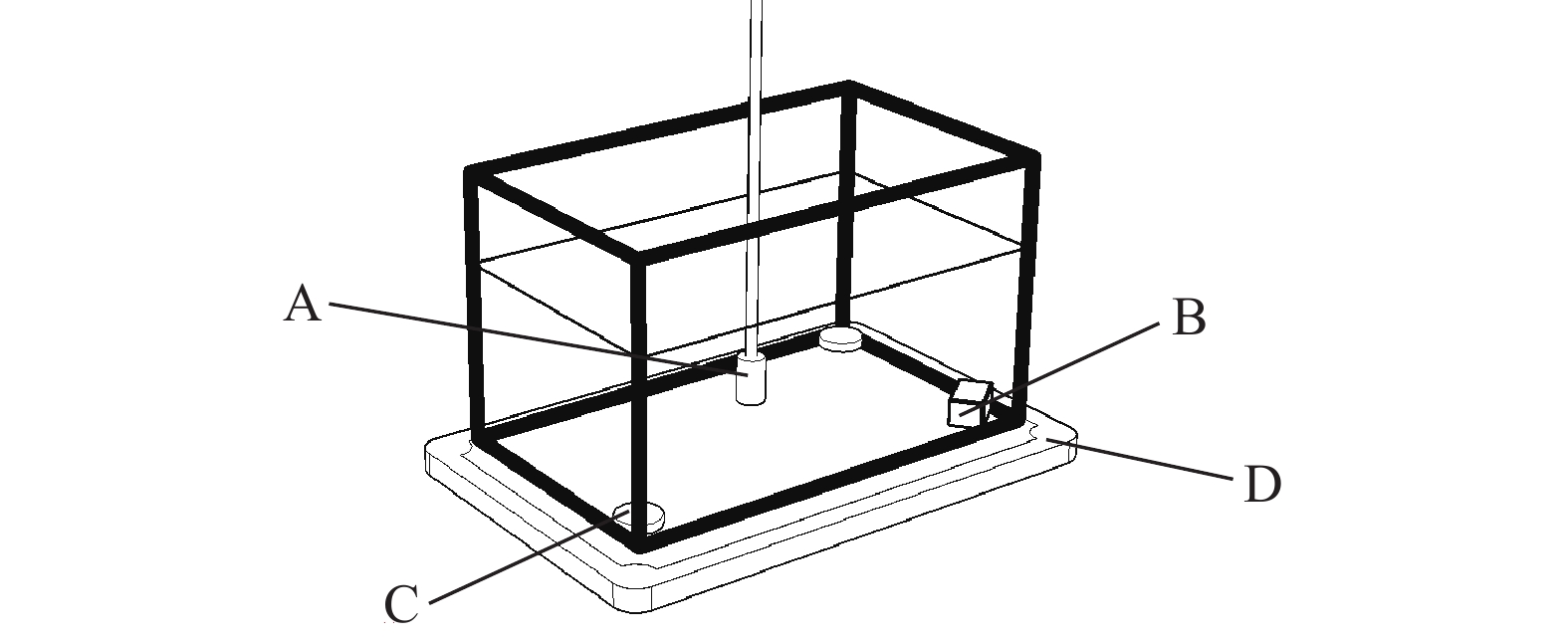
 下载:
下载:
